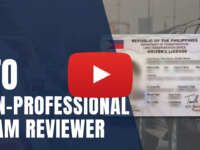Which one of the following is considered real property?
Select one:
A. An automobile
B. A house
C. Furniture
D. A motorhome
Correct. Real property includes tangible property consisting of land and all structures permanently attached to the land, such as a family’s home (house). Motor vehicles and furniture are examples of personal property.
John is a recent homeowner and is considering the insurance coverages he needs for his home and contents. If damaged by a peril covered by a homeowners policy, which one of the following would be considered part of John’s real property?
Select one:
A. The desk top computer
B. The detached garage
C. The boat in the driveway
D. The hockey net and equipment
Correct. The detached garage would be considered part of John’s real property.
Which one of the following statements regarding assets exposed to loss is true?
Select one:
A. Real property includes intangible property.
B. Earthquake damage to a swimming pool is an example of a personal property exposure.
C. Personal property includes only tangible property.
D. Lightning damage to a tree is an example of a real property loss exposure.
Correct. Lightning damage to a tree is an example of a real property loss exposure.
A family rents its vacation home to others for several months each year. A fire caused extensive damage to the home just before the rental season began one year, and the family was unable to collect any rent on the property until it was repaired. This inability to collect rent is an example of which one of the following outcomes of loss?
Select one:
A. Lost income
B. Increased expenses
C. Reduction in value of property
D. Special damages
Correct. Lost income refers to loss of income that results if property is damaged and the owner is unable to collect any rent on the property until it is repaired.
Which one of the following statements regarding assets exposed to loss is true?
Select one:
A. Real property includes only tangible property.
B. Earthquake damage to a swimming pool is an example of a personal property loss exposure.
C. Personal property includes only tangible property.
D. Hail damage to a motor vehicle is an example of a real property loss exposure.
Correct. All real property is tangible property having a physical form that can be seen or touched. Personal property can include intangible property such as patents or copyrights.
A family suffered extensive fire damage to its home and was temporarily unable to inhabit it. The family was forced to rent a hotel room while its home was under repair. The cost incurred to rent the hotel room is referred to as which one of the following outcomes of loss?
Select one:
A. Lost income
B. Increased expenses
C. Reduction in value of property
D. Special damages
Correct. Increased expenses are expenses in addition to normal living expenses that are necessary because of a loss.
All of the following items are examples of personal property, EXCEPT:
Select one:
A. Sports equipment
B. Silverware
C. A fishing boat
D. Underground pipes
Correct. Personal property includes all tangible or intangible property that is not real property. Real property includes tangible property consisting of land and all structures permanently attached to the land, and anything embedded in the land.
In general, a loss prevention measure is implemented to
Select one:
A. Eliminate any possibility of loss.
B. Reduce loss severity.
C. Break the sequence of events that leads to a loss.
D. Keep backup information and assets in reserve.
Correct. In general, a loss prevention measure is implemented to break the sequence of events that leads to a loss.
All of the following could lead to a liability loss for a family, EXCEPT:
Select one:
A. The daughter, who is 16 years old, sideswipes a neighbor’s car and dents its fender while driving her own car.
B. The father trips on a broom he left lying in the driveway and breaks his arm.
C. A guest slips on an icy sidewalk in front of the family’s home and breaks his leg.
D. The son, who is 13 years old, throws a rock at a classmate who requires stitches for an injury to his head.
Correct. The only example listed that is not a liability loss exposure for a family is the injury to the father.
An individual’s liability losses
Select one:
A. May not exceed the value of all of his or her assets, including both personal and real property.
B. May consume most of his or her present assets and future income.
C. May not exceed the value of his or her real property.
D. May not exceed the amount of his or her current income.
Correct. An individual’s liability losses may consume most of his or her present assets and future income.
Which one of the following is a form of compensatory damages?
Select one:
A. Real damages
B. Punitive damages
C. Special damages
D. Exemplary damages
Correct. Special damages are a form of compensatory damages.
All of the following are true of the HO-3 Special Form, EXCEPT:
Select one:
A. The HO-3 can be modified for special needs through available endorsements.
B. The HO-3 meets the property and liability coverage needs of most families.
C. The HO-3 is designed for owners who occupy their dwelling or choose to rent it.
D. The HO-3 is typically used as a basis for understanding other HO coverage forms.
Correct. All answers are correct except for: The HO-3 is designed for owners who occupy their dwelling or choose to rent it.
Green Insurance Group offers new literature that addresses special considerations for homeowners’ growing use of smart products, interconnected devices, and the Internet of Things. Green makes sure its customers understand that one drawback to these new smart products is
Select one:
A. Data generated from the IoT creates exposures to data security and privacy issues.
B. Past claims data is still the only reliable way to assess risk and set prices.
C. Smart contracts will still require adjuster involvement in a claim.
D. Sensors in home appliances and cooling systems are too cost prohibitive.
Correct. Data generated from the IoT creates exposures to data security and privacy issues.
The primary factors that most states and companies use for determining the cost of personal auto insurance include all of the following, EXCEPT:
Select one:
A. Territory
B. Driver age
C. Use of the auto
D. Vehicle horsepower
Correct. Driver age is a primary rating factor.
Insurers and other organizations that make insurance available to those who are unable to obtain coverage from the standard market are collectively called
Select one:
A. A reinsurance facility.
B. The residual market.
C. The secondary market.
D. An automobile insurance plan.
Correct. Insurers and other organizations that make insurance available to those who cannot obtain coverage from the standard market are called the residual market.
Which one of the following is the most commonly used method of compensating auto accident victims?
Select one:
A. Financial responsibility laws
B. Tort liability system
C. Uninsured motorist coverage
D. Unsatisfied judgment funds
Correct. The tort liability system is the most commonly used method of compensating auto accident victims.
Under the tort liability system, injured accident victims must prove that
Select one:
A. Another party was at fault before they can collect damages.
B. They are unable to purchase insurance from another source before they can collect damages.
C. The insurance limits they have purchased are equal to or greater than the state minimum limits before they can collect damages.
D. They have met the financial responsibility laws of the state before they can collect damages.
Correct. Under the tort liability system, injured accident victims must prove that another party at fault before they can collect damages.
A plan for insuring high-risk drivers, in which all auto insurers doing business in the state are assigned their proportionate share of high-risk drivers based on the total volume of automobile insurance written in a state, is
Select one:
A. A joint underwriting association.
B. A reinsurance facility.
C. Excess and surplus lines.
D. An automobile insurance plan.
Correct. A plan for insuring high-risk drivers in which all auto insurers doing business in the state are assigned their proportionate share of high-risk drivers based on the total volume of automobile insurance written in a state is an automobile insurance plan.
Insurance score as a rating factor for an individual auto insurance applicant is based on which one of the following?
Select one:
A. Loss history
B. Financial history
C. Territory demographics
D. Income data
Correct. Insurance score as a rating factor for an individual auto insurance applicant is based on the individual’s financial history.
Which one of the following statements is true regarding automobile insurance rating?
Select one:
A. State regulators require that all insurers offer discounts on auto rates for passive restraints.
B. Most insurers base automobile rates on primary rating factors and do not consider any other factors in establishing rates.
C. State regulators require that rates be adequate, reasonable, and not unfairly discriminatory.
D. Drivers with lower-than-average loss exposure are charged higher rates.
Correct. State regulators require that rates be adequate, reasonable and not unfairly discriminatory.









0 Comments